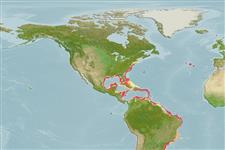Common names from other countries
>
Carangiformes (Jacks) >
Carangidae (Jacks and pompanos) > Naucratinae
Etymology: Seriola: Latin word diminutive with the meaning of a large earthenware pot (Ref. 45335).
More on author: Bloch.
Environment: milieu / climate zone / depth range / distribution range
Écologie
marin benthopélagique; profondeur 55 - 348 m (Ref. 51158). Subtropical; 43°N - 30°S, 98°W - 15°W
Western Atlantic: Massachusetts, USA to Brazil. Eastern Atlantic: Madeira (Ref. 7097); Turkey (Ref. 95646); eastern Atlantic distribution is uncertain due to past confusion with Seriola carpenteri.
Taille / Poids / Âge
Maturity: Lm ? range ? - ? cm
Max length : 67.5 cm FL mâle / non sexé; (Ref. 26340); common length : 50.0 cm TL mâle / non sexé; (Ref. 5217); poids max. publié: 4.6 kg (Ref. 3195)
Épines dorsales (Total): 9; Rayons mous dorsaux (Total): 28-33; Rayons mous anaux: 17 - 20
Adults are benthopelagic near the coasts (Ref. 5217). Smaller juveniles epipelagic in oceanic or offshore neritic waters. Adults feed on squids and fishes (Ref. 4233). Eggs are pelagic (Ref. 4233).
Life cycle and mating behavior
Maturité | Reproduction | Frai | Œufs | Fécondité | Larves
Smith-Vaniz, W.F., J.-C. Quéro and M. Desoutter, 1990. Carangidae. p. 729-755. In J.C. Quero, J.C. Hureau, C. Karrer, A. Post and L. Saldanha (eds.) Check-list of the fishes of the eastern tropical Atlantic (CLOFETA). JNICT, Lisbon; SEI, Paris; and UNESCO, Paris. Vol. 2. (Ref. 7097)
Statut dans la liste rouge de l'IUCN (Ref. 130435)
CITES (Ref. 128078)
Not Evaluated
Menace pour l'homme
Reports of ciguatera poisoning (Ref. 30911)
Utilisations par l'homme
Pêcheries: pêcheries vivrières; pêche sportive: oui
Plus d'informations
RéférencesAquacultureProfil d'aquacultureSouchesGénétiqueElectrophoresesHéritabilitéPathologiesTraitementMass conversion
Outils
Articles particuliers
Télécharger en XML
Sources Internet
Estimates based on models
Preferred temperature (Ref.
115969): 17.7 - 26.5, mean 23.3 (based on 70 cells).
Phylogenetic diversity index (Ref.
82804): PD
50 = 0.5020 [Uniqueness, from 0.5 = low to 2.0 = high].
Bayesian length-weight: a=0.01549 (0.00869 - 0.02760), b=2.95 (2.79 - 3.11), in cm Total Length, based on LWR estimates for this species & (Sub)family-body (Ref.
93245).
Niveau trophique (Ref.
69278): 4.6 ±0.57 se; based on food items.
Résilience (Ref.
120179): Milieu, temps minimum de doublement de population : 1,4 à 4,4 années (Preliminary K or Fecundity.).
Fishing Vulnerability (Ref.
59153): Moderate to high vulnerability (50 of 100).
